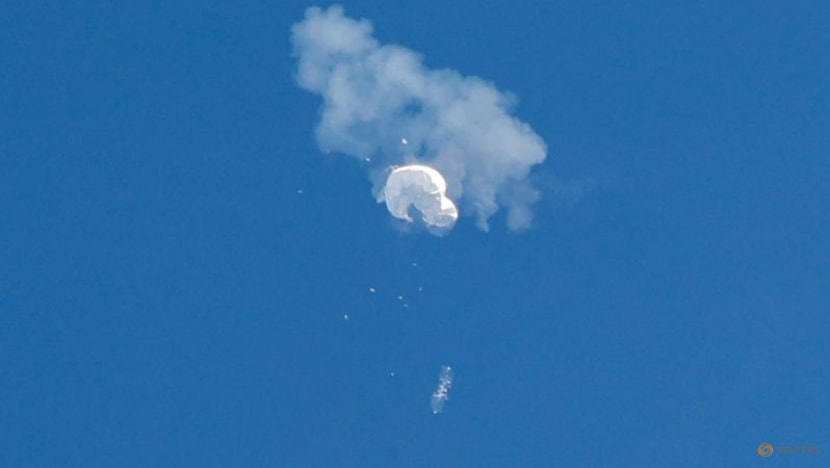Commentary: Spy balloon or not, history cautions against overreaction in latest tension to US-China relations
It should come as no surprise that powerful countries engage in surveillance, but history cautions against overreaction, says political observer Robert Kelly.

The suspected Chinese spy balloon drifts to the ocean after being shot down off the coast in Surfside Beach, South Carolina, on Feb 4, 2023. (Photo: REUTERS/Randall Hill)
SEOUL: Since Thursday (Feb 2), Americans had been transfixed by the weird spectacle of a suspected Chinese surveillance balloon traversing the country. The balloon was shot down on Saturday after it drifted over the ocean, for fear of debris falling on people.
China claimed that it was a weather balloon blown off course, accusing the United States of “overreacting”. US Secretary of State Antony Blinken postponed his widely anticipated trip to Beijing on the eve of his departure.
It is unclear what intelligence China might have gleaned. There is concern that it identified US missile silos, but these are large, obvious targets the Chinese probably knew about already. US officials have said that the balloon was unlikely to add significant value to intelligence gathered from other capabilities, such as low-Earth orbit satellites.
Still, this incident adds new tension to chilly relations, but this need not lead to a crisis unless US or China let it.
GREAT POWERS SPY ON EACH OTHER
It should surprise no one that large, powerful countries engage in surveillance against other states.
The Chinese have sent other surveillance balloons toward the US in the past few years. The United States has done this for decades against its various opponents, and sometimes even against partners and allies.
The most curious part of this incident, rather, was the balloon’s very public appearance over continental US. People with standard cameras with zoom lenses could see it - and filmed it and put it on social media.
Unsurprisingly, this provoked a lot of popular comment and news coverage, which is very unusual in the world of spying and intelligence. Could stirring up a national debate in the US have been its purpose, or perhaps to see the political response? Because it was almost inevitable that the balloon would be seen.
The incident predictably provoked partisan political commentary about Chinese intentions. Trump, running for president yet again, naturally weighed in to stir up controversy. Hawks framed the balloon as an incursion, and this very public incident will only harden the congealing anti-Chinese consensus in Washington, especially in Congress.
The most famous analogous incident is the American use of high-altitude U-2 spy planes over the Soviet Union during the early years of the Cold War. The Soviets managed to shoot down a U-2 and stage a show trial of its pilot, Francis Gary Powers, in 1960.
Like China last week, the first American response was to claim that aircraft was on a weather operation.
In 1962, Cuba shot down another U-2 in the midst of the missile crisis. Similarly, the US routinely flies surveillance planes near the legal airspace limits of North Korea and China. One of those planes was struck by a Chinese fighter jet in 2001 and its crew captured.
INCIDENTS ARE INEVITABLE BUT MANAGEABLE
This history should caution against overreaction.
As two large, wealthy, militarily powerful states with different ideologies, competition between the US and China is all but inevitable. Intelligence gathering, spying, hacking, satellite coverage, are part of this, creating friction points.
Unavoidably, some spies and surveillance crews get caught, leading to awkward denials, exhibitions of wreckage and prisoner swaps. These events are tense, creating genuine geopolitical risk, which is likely why they are memorialised in Hollywood’s regular stream of spy movies.
But critically, these altercations are also manageable. Across the 45 years of the Cold War, intelligence gathering never led to an outbreak of conflict nor decisively tilted the military balance against the US or the Soviet Union.
Both sides recognised that both were spying. While these created many ostensible breaches of international law, the Americans and Soviets were cautious in exploiting the resulting tension. The Soviets returned downed U-2 pilot Powers to the US and then president John Kennedy rejected pressure to strike Cuba after the 1962 U-2 shootdown.
Listen: Rare access to a warship in the South China Sea

US President Joe Biden should do the same. If he draws a sharp, public red line against China over this balloon incident, he will eventually be shown up as a hypocrite because the US is almost certainly spying on China too. A red line would also back Biden into a corner where he would be committed to escalation if this happens again.
HOLD OFF US-CHINA COLD WAR
This is just something both sides must learn to live with. Their actions so far suggest the US and China understand this.
Biden ordered the balloon to be shot down and can tell his public that the US will salvage and learn about China’s capabilities from the debris. According to a CNN report, US officials spoke to their Chinese counterparts throughout the week. There is work going on behind the scenes, and importantly, communication.
The US and China are sliding into a cold war. This is widely accepted in the scholarly community, and the US foreign policy community in Washington has turned sharply against China in the last few years.
But just because a cold war is likely does not mean anyone should encourage it. US and China - from political leaders, analysts and even the public - should try as best we can to prevent incidents like this balloon shootdown from worsening tensions and hurtling the world towards a full-blown crisis, starting by not overreacting.
China’s economic ability to sustain a global shadow conflict with the US is far greater than the Soviet Union’s. A twilight struggle with China could last decades and have more dangerous repercussions. Both the US and China will need to learn to better contain and manage such incidents if they are going to avoid - as they should - a superpower clash over a spy balloon.
Robert Kelly (@Robert_E_Kelly) is a professor of international relations in the Department of Political Science at Pusan National University.

















